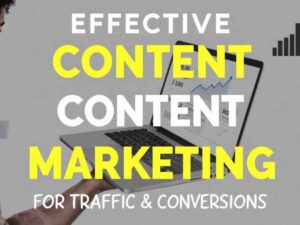Content Marketing Strategies That Drive Traffic and Conversions

And did you know that content marketing produces three times the number of leads as paid search at a cost that is 62% lower? Certainly, that’s why companies from every sector are embracing this potent strategy in order to drive growth in their online presence and conversion rates.
But there’s a catch — not every content marketing strategy is created equal. Just because you create good content doesn’t mean it’s going to attract the right people or drive the action you want.
This blog will feature pragmatic content marketing strategies that can generate traffic and conversions. We’ll stress for the importance of SEO, offer tips for creating results-oriented content, and talk about how to use tools as diverse as email and social media to increase the reach of your work. It doesn’t matter if you’re a small business owner, blogger, or marketer, these strategies are so powerful, they’ll give you the insight you need to make smarter, more result-driven content decisions!
What is Content Marketing Strategies?
The basics of content marketing are that you create and distribute valuable, relevant content to a well-defined target to attract or engage a clearly defined audience. The ultimate goal? To encourage valuable customer actions such as website visits, leads, and sales.
Key Pillars of Content Marketing:
- Relevance: The information you provide should help to solve the problems, fulfill the needs or grab the interests of your audience.
- Valuable: Offer what your audience will consider solutions, education, or entertainment.
- Regularity: By doing so you can gain trust and become an authority in your market by consistently publishing quality content.
Content marketing is a process that supports other digital strategies such as SEO. Quality content helps you rank higher in SERP, helping users find you organically. As it builds trust and creates value, content marketing draws casual traffic back to become loyal customers.

The Role of SEO in Content Marketing
SEO is the foundation on which successful content marketing is built. Without proper SEO, the best articles and videos may never get seen. Optimize content and increase the potential you have for discovery by the population you are trying to reach.
Why SEO Matters:
Keyword Research
Good content begins with knowing what your customers are looking for. Find key words related to your industry and the intent of your audience. Tools like Ahrefs, SEMrush, and Google Keyword Planner make it easy to do this.
Optimize Your Content
Apply the best SEO practices to get your blogs, pages, and videos to rank well. This means targeting keywords in headings, meta descriptions, alt text, and URL structure.
Create High-Quality Content
Google prioritizes value. The more unique, deep and relevant the content that you publish – the more likelihood there is that you’ll rank well on Google. Put the effort on solving problems and answering the user’s question.
Blogging for Traffic
Blogs continue to be one of the SEO’s best tools. Regularly posting optimized blog content can lead to an increase in organic traffic, whilst also establishing your brand as an authority.
Example:
If you are an eco-friendly fashion e-commerce store, then you can write blogs like “5 Eco-Friendly Accessories You Can’t Miss” or “Sustainable Ways to Create a Capsule Wardrobe.” Put SEO-friendly headers to work and make sure readers stumble across tips they can use.

Content Creation Strategies That Convert
The challenge here is in having traffic turn into conversions, and that is done with content so engaging that your crowd can’t help but interact with it. The following are four battle-tested strategies to help guide your work:
1. Know Your Audience
Knowing your audience is the cornerstone of good content marketing. Take time to map out their:
- Demographics
- Pain points
- Goals
- Preferred platforms
You can create content that will truly resonate with them, as you’ll know what they want, and need. For instance, if you are a SaaS company serving startups, you might create blogs or videos on “How to Improve Productivity in Remote Teams.”
2. Provide Solutions
Your content ought to be the solution to questions, problems or needs. For instance:
- A skincare line might distribute a how-to like “How to Treat Acne in the Winter.”
- A financial planner could create educational videos about “Saving for Your First Home.”
As I mentioned above, when you show your leads real, physical value, they will be more apt to trust your brand and do something more in the future, And in fact, that action could be anything from: Becoming a subscriber, Making a purchase, Scheduling a demo.
3. Craft Effective CTAs (Call-to-Actions)
The right call-to-action makes all the difference between traffic and conversion. Some examples:
- “Grab our free marketing toolkit here.”
- “Become a member now for free shipping!”
- “Schedule your free 15-minute consultation now.”
Pro Tip: A/B test different CTAs to determine what produces the best conversion rates.
4. Use High-Quality Visuals
Visuals significantly enhance engagement. Incorporate:
- Infographics: Ideal for digesting data-heavy insights.
- Videos: Whether it’s a tutorial, product demo, or behind-the-scenes clip, videos can help to increase both traffic and conversions.
- Images: Great, professional looking images are what makes your blogs and social posts pop.

How to Leverage Email Marketing for Engagement
Email and content marketing are a match made in heaven. Emails provide a direct line to your audience, so they are a great tool for engagement.
Steps to Engage with Email Marketing:
Build Your List
Capture leads by giving away valuable gated content such as e-books, guides, or exclusive templates.
Segment Your Audience
Personalization drives better results. Segment your email list by customer wants or needs, and send the content based on what they like.
Share Valuable Content
Send links to your recent blogs, special offers or your webinars via email. Keep the subject line catchy and the message short for better open rates.
Content Distribution Channels That Maximize Reach
The finest content in the world will tank if nobody sees it. Here’s how to make sure your work reaches as large an audience as possible:
1. Social Media Platforms
Distribute your content on platforms where your audience is present. They’re often taking place on Instagram, LinkedIn and Facebook.
2. Guest Blogging
Creating guest posts published on reputable sites will expand your reach and provide quality backlinks for improved SEO.
3. Paid Content Promotion
Never bind an idea to a single format! Repurpose blogs into infographics or podcasts, or tweak them into short-form videos for outlets like TikTok.
4. Repurposing Content
Never bind an idea to a single format! Repurpose blogs into infographics or podcasts, or tweak them into short-form videos for outlets like TikTok.

Conversion Rate Optimization (CRO) Techniques for Content
Your content investment is worthwhile with Conversion rate optimization. Here’s how to ensure every piece of content matters:
A/B Testing
Try different headlines, CTAs, or formats to find what works. Compare, for instance, “Download Our Guide” vs. “Get Your Free Toolkit.”
Optimize Landing Pages
Your blog or campaign landing page should address one problem. Use clear headline, scannable content and trust indicators (reviews, testimonials).
Use Trust Signals
Include reviews, testimonials, or security badges so that visitors know that you’re a reliable source.
How to Measure the Success of Your Content Marketing
Tracking performance is critical to refining your strategy. Monitor KPIs like:
- Website traffic and referral sources
- Bounce rate
- Conversion rate
- Social shares and engagement
Use tools like Google Analytics, SEMrush, and Hootsuite to evaluate your efforts.

The Final Word on Content Marketing Strategies
There is so much power in content marketing to not only attract traffic and grow authority, but to turn those browsers into buyers. Use the steps above, and you’ll have a successful plan for the long-term.
Ready to kick your content marketing up another notch? Get our free content marketing toolkit and start working on more intelligent strategies today. Still have questions? Let us know in the comments and we’ll help you out!
Frequently Asked Questions (FAQ)
What is content marketing, and why is it important?
Content marketing is a strategy focused on creating and distributing valuable, relevant, and consistent content to attract and retain a clearly defined audience. It’s important because it helps businesses build trust, engage with potential customers, and drive conversions organically.
How does content marketing drive traffic to my website?
When you consistently produce useful and engaging content for the people you want to reach, you’re naturally going to do better in terms of search engine results, social shares, and engagement, all of which will help you attract traffic.
What tools can I use to improve my content marketing strategy?
There are all kinds of tools out there-channels such as Google Keyword Planner, Hootsuite (for social media) and Analytics (thanks Google). Don’t forget to download your free content marketing toolkit at the end of this post!
How long does it take to see results from content marketing?
Content marketing is a long game. Small victories can occur quickly, to be sure, but typically you’re looking at more like months of steady effort to move the needle much on metrics such as traffic, engagement and conversions.
What should I do if I have more questions about content marketing?
Contact me by commenting on this blog post! We can help you with and give you all the guidance necessary to expand your content marketing operation’s reach.





